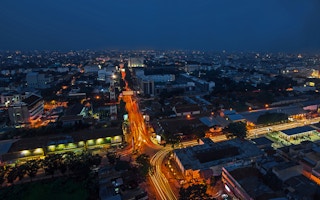Indonesia, with over 17,000 islands and 300 languages and ethnic identities, is the world’s fourth most populous nation. Southeast Asia’s largest economy – and the world’s 19th largest – is the region’s only representative at the G20. The country boasts annual gross domestic product (GDP) growth rates of 6 per cent or more, making it one of the fastest growing economies outside of India and China.
Indonesia cannot be described by statistics and superlatives alone. Ask any of the country’s estimated 6 million annual visitors, and they would probably agree that figures only provide a peep through the keyhole of one of the global economy’s best kept secrets.
For statistics-focussed investors however it is often all about the numbers, and they make compelling reading;
- 238 million – population at a conservative estimate, equating to huge market potential
- $2,580 p.a. – gross national income per capita and rising (World Bank), equating to strengthening consumer spending
- 6.1 per cent - GDP growth in 2010, and forecast to reach 6.5 per cent in 2011
The list goes on… In these uncertain economic times, Indonesia is being considered in a new light by the world’s investment community.
In parallel, and since the global financial crisis (the 2008 vintage, in case you were wondering), a curious thing has also been happening within the same investment community. Many institutional investors, who have traditionally focussed on more conventional investments (e.g. bonds, fixed income, listed stock etc.) have been re-evaluating the role alternative asset categories (such as private equity and asset management) have to play in post-crisis portfolio construction. With many private funds outperforming their listed counterparts during the same period, the trend points towards increasing allocations to credible private equity managers.
So what then are the prospects for private equity (PE) funds in a fast growing market like Indonesia? This article examines the landscape, opportunities and challenges they face, and will be followed in a second piece by a more in-depth look at the relatively untapped opportunities in green business infrastructure.
For a start, many funds are raising fresh capital - a healthy barometer of the state of any industry. We have seen activity from both Indonesian fund managers as well as pan-Asean funds with Indonesian allocations. According to Asian Private Equity Review, Indonesian fund managers alone could raise up to US$1billion of new capital by the end of 2011. Leading the way are emerging country specific fund managers such as Ancora Capital, Quvat Capital Partners, Saratoga Capital and Northstar Pacific, all of whom already have sizeable funds under management. They are being joined by Falcon House Partners and Syailendra Capital, each with established investor networks.
“
The renewed interest in Indonesia, and the Southeast Asia block as a whole, has coincided with a period of sustained and stable economic growth at a time when more conventional private equity markets of Europe and North America are in distress.
In addition, numerous recent reports (from Cogent Partners and Collier Capital, among others) suggest that the global market for buying and selling investments into PE funds (referred to as secondary positions) is now sizeable and growing. This is a good omen for the industry, especially for regional PE funds and those with a strong sector focus, which includes renewable energy, and sustainable and clean-tech investments.
The reason this is important is that these PE funds can approach a larger universe of potential investors. Previously, many mainstream investment institutions were deterred by concerns around liquidity. Investments were often structured in a way that meant investors only got their capital and returns back at the end of the fund life – often as much as 8 or 10 years depending on the fund. Making it easier to trade investment positions makes it a more palatable market to a wider range of institutions.
The renewed interest in Indonesia, and the Southeast Asia block as a whole, has coincided with a period of sustained and stable economic growth at a time when more conventional private equity markets of Europe and North America are in distress. Indonesia is starting to see the benefits of the ‘reformasi‘; Indonesian for the reform program launched after the fall of former Dictator Suharto.
Its commercial spirit was reflected in the findings of a May 2011 BBC World Service Poll which found Indonesia to be the best place for entrepreneurs to start a business, ahead of the US, Canada, India and Australia! Who would have predicted that barely 15 years ago, as the country reeled from the effects of dictatorship and the Asian financial crisis?
As many Western Countries struggle with their own difficulties, perhaps this is a fine example that opportunity abounds and no crisis lasts forever.
At the same time, a June 2011 industry survey by the international legal practice Norton Rose found that 96 per cent of respondents agreed that there is a requirement for increased foreign investment into Indonesia. 86 per cent thought that foreign investment would increase over the next two years with 21 per cent of those suggesting this increase would be significant. 94 per cent felt that the private sector had a role to play and 92 per cent view mining and minerals as offering the most potential for investment.
And so where has private capital been deployed? Traditionally, most investment firms have targeted the extractive resources, shipping and infrastructure sectors. However, over the last ten years virtually every sector in the Indonesian economy has experienced attractive yet stable growth, which inevitably creates opportunity.
Telecoms, clean energy, renewables, manufacturing, commercial retail, service industries, financial institutions, transportation and tourism are all growth sectors and attracting the eye of Indonesian investors.
But (and there is always a ‘but’…), Indonesia still faces a number of age-old issues it needs to overcome.
Indonesia remains a challenging place to do business, especially for foreigners. It ranks 129 out of 183 in the 2012 World Bank ease of doing business index. The Norton Rose survey mentioned above found that 58 per cent of respondents rated the bankability of Indonesian projects as poor, while 57 per cent of respondents still perceive Indonesia as a risky investment destination.
Corruption, wasteful subsidies, overlapping government bodies and an inefficient bureaucracy are common complaints in a country where personality and connections often trump transparency and process when doing business. The country’s transportation, logistics and telecommunications infrastructure remain inadequate, struggling to play catch-up as the country’s needs continue to develop. Left unaddressed, these issues have the potential to act as a handbrake on growth and to stifle domestic investment and in many cases, deterring overseas investors.
Many Indonesian and international publications this year have highlighted the threat these factors pose to Indonesia’s hard won business credibility. If that is a ‘glass half empty’ approach, then the ‘glass half full’ view might be to imagine what the economy could do if it were freed of these shackles. China style growth rates of 8 per cent per year or more? Who knows, but it would be nice to find out.
A generation ago, many emerging economies competed for investments from the same pool of capital. Today, these countries are in a better position to choose between investors and select those who best align with their needs. In an interview I read after the global financial crisis, Lord Mark Malloch-Brown, former Vice Chairman of Soros Fund Management and minister in Gordon Brown’s cabinet talked about how foreign investors might best adapt to these new opportunities. He said “private equity investors are therefore going to have to prove that they can be long-term partners prepared to contribute to local society and the growth of the country. They are going to have to be focused on job creation, demonstrate commitment to corporate and social responsibility and contribute to tax revenues.” He added “…a number of attractive opportunities clearly exist… deal [investment] sizes can be smaller and exits can be a challenge. As a result, successful investing in these areas requires a very careful balance between deal size, due diligence, knowledge of local environment and an ability to get involved in operations.”
Future prospects will depend on the current environment of stable growth being maintained, because fundamentally it is the attraction of a better return that is the magnet for investment capital. But improvements to the ease of doing business will be just as important if Indonesia’s full potential is to be unlocked.
This article will be followed by “Opportunities for green / sustainable investments in Indonesia and South East Asia”.
Brandon Courban is Investment Director at Low Carbon Investors, a specialist asset manager launching a private equity fund investing in green business opportunities in SE Asia from a base in Singapore. The views expressed in this article are his alone, and do not necessarily represent the views of the Low Carbon Investors Group.


















